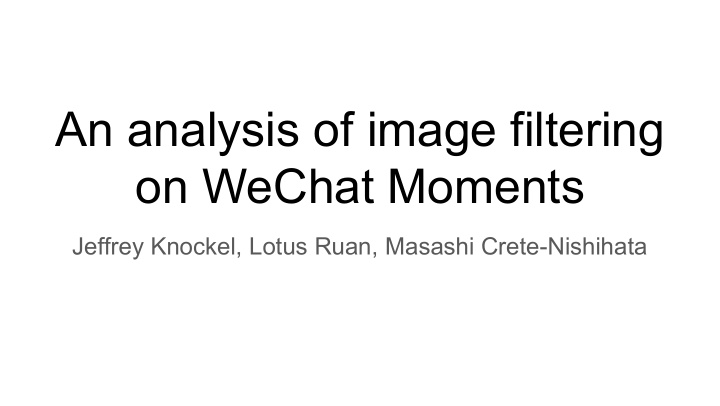



An analysis of image filtering on WeChat Moments Jeffrey Knockel, Lotus Ruan, Masashi Crete-Nishihata
Background ● Images increasingly used to communicate ● Image censorship understudied ● (Website blocking, text chat/posts, etc.)
WeChat Moments ● WeChat has over 1 billion active users ● Images are most frequent content on WeChat Moments ● Previous work systematically looked at text ● Known to automatically filter politically sensitive images for China-based accounts
Source: https://isc.sans.edu/forums/diary/23395
Source: https://isc.sans.edu/forums/diary/23395
● Why didn’t the wavey thing evade? ● Why did the scribble evade? Does doing the scribble always evade?
● We want effective techniques ● We want principles-based techniques (based on understanding principles of how the filter works)
How we develop evasion techniques 1. Understand filter’s implementation details a. Modify otherwise filtered images b. See which modification evade filtering 2. Devise and test evasion strategies
How we develop evasion techniques ● By learning how to evade it we can learn how the filtering algorithm works ● By learning how the filtering algorithm works we can learn how to evade it
Our findings ● Two methods of filtering ● OCR-based (blacklisted keywords) ● Visual-based (blacklisted images)
“ ” 法輪大法好 OCR: “FALUN DAFA IS GOOD”
OCR performs grayscale conversion
Does WeChat use grayscale? How? ● Average ( r + g + b ) / 3 ● Lightness (max( r + g + b ) + min( r + g + b )) / 2 ● Luminosity 0.299 ⋅ r + 0.587 ⋅ g + 0.114 ⋅ b
Background chosen to have same luminosity of text
If background is luminosity: Average ❌ ( r + g + b ) / 3 Lightness ❌ (max( r + g + b ) + min( r + g + b )) / 2 Luminosity ✔ 0.299 ⋅ r + 0.587 ⋅ g + 0.114 ⋅ b
Create messages where each line contains a blacklisted phrase. Tested 6 colors…
For each color, vary the # of sensitive phrases 5 times…
For each color and # of sensitive phrases we generated five messages… All 150 messages evaded filtering!
OCR performs blob merging
Squares Letters
Varied the pattern (squares and letters) Varied # of sensitive phrases 5 times 48/50 evaded filtering! ✔
Visual-based filtering Works when image contains no text
High level machine learning categorization? Cat
High level machine learning categorization? Dog?
Mirroring consistently evaded filtering So do some other simple modifications like removing/adding whitespace
High level machine learning categorization? Training to recognize sensitive content would be difficult considering the… ● subtlety of what makes something sensitive ● fluidity of what is considered sensitive
Is color important? Converting images to grayscale never evaded filtering
Does it convert to grayscale? How? Use same method we used to test OCR
Converts to grayscale using luminosity
Are edges important?
Are edges important? Thresholding preserves edges, removes other information Thresholded 15 images, only 2 evaded
Are edges important? Proportionally resized 15 images such that each image’s smallest dimension(s) are 200 px. How much can we blur before evasion? Doesn’t take much! Largest normalized box filter kernel size
Are edges important?
How are images resized? Hypotheses: 1. Proportionally such that their width is some value such as 100. 2. Proportionally such that their height is some value such as 100. 3. Proportionally such that their largest dimension is some value such as 100. 4. Proportionally such that their smallest dimension is some value such as 100. 5. Both dimensions are resized to some fixed size such as 100×100.
How are images resized? Hypotheses: 5. Both dimensions are resized to some fixed size such as 100×100. Stretching an image evades filtering.
If space added to width but resizes by width or largest dimension, will not match
Correct hypothesis: 4. Proportionally such that their smallest dimension is some value such as 100. Evade filtering by adding borders to the smallest dimension.
Adding surrounding content Adding duplicate images generally evaded. Full results are in our paper.
Conclusion An effective image filter evasion strategy is one that modifies a sensitive image so that it… 1. no longer resembles a blacklisted image to the filter but 2. still resembles a blacklisted image to people reading it.
Evasion technique summary ● OCR-based evasion ○ By color (100%) ○ By blobs (96%) ● Visual-based evasion ○ Mirroring (100%) ○ Blurring (varies) ○ Stretching (97%) ○ Adding borders (80%) ○ Adding complex content around the image (varies)
Conclusion We only looked at one platform, but we hope that this type of analysis provides a roadmap for looking at filtering on other platforms. https://citizenlab.ca/2018/08/cant-picture-this-an-analysis-of-i mage-filtering-on-wechat-moments/
Questions?
Recommend
More recommend